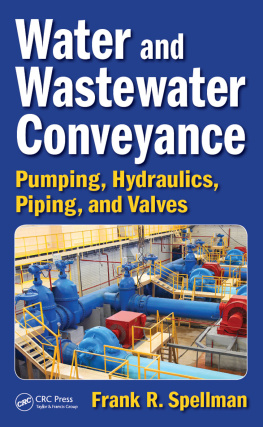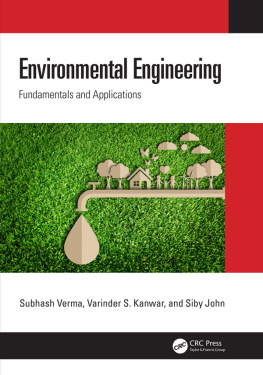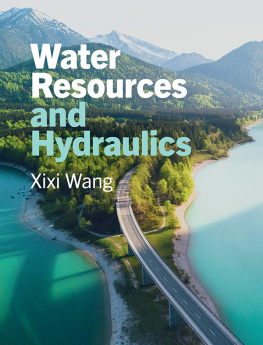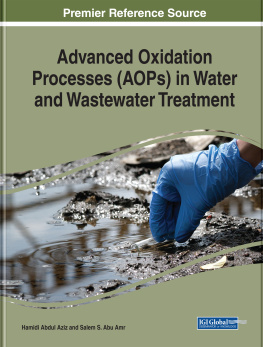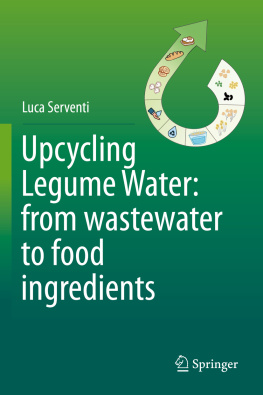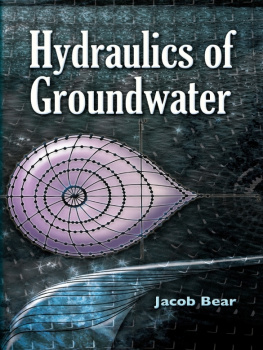Spellman - Water and wastewater conveyance: pumping, hydraulics, piping, and valves
Here you can read online Spellman - Water and wastewater conveyance: pumping, hydraulics, piping, and valves full text of the book (entire story) in english for free. Download pdf and epub, get meaning, cover and reviews about this ebook. year: 2017, publisher: CRC Press, genre: Children. Description of the work, (preface) as well as reviews are available. Best literature library LitArk.com created for fans of good reading and offers a wide selection of genres:
Romance novel
Science fiction
Adventure
Detective
Science
History
Home and family
Prose
Art
Politics
Computer
Non-fiction
Religion
Business
Children
Humor
Choose a favorite category and find really read worthwhile books. Enjoy immersion in the world of imagination, feel the emotions of the characters or learn something new for yourself, make an fascinating discovery.
Water and wastewater conveyance: pumping, hydraulics, piping, and valves: summary, description and annotation
We offer to read an annotation, description, summary or preface (depends on what the author of the book "Water and wastewater conveyance: pumping, hydraulics, piping, and valves" wrote himself). If you haven't found the necessary information about the book — write in the comments, we will try to find it.
Spellman: author's other books
Who wrote Water and wastewater conveyance: pumping, hydraulics, piping, and valves? Find out the surname, the name of the author of the book and a list of all author's works by series.
Water and wastewater conveyance: pumping, hydraulics, piping, and valves — read online for free the complete book (whole text) full work
Below is the text of the book, divided by pages. System saving the place of the last page read, allows you to conveniently read the book "Water and wastewater conveyance: pumping, hydraulics, piping, and valves" online for free, without having to search again every time where you left off. Put a bookmark, and you can go to the page where you finished reading at any time.
Font size:
Interval:
Bookmark:

Water and Wastewater Conveyance
Pumping, Hydraulics, Piping, and Valves
Water and Wastewater Conveyance
Pumping, Hydraulics, Piping, and Valves
Frank R. Spellman

CRC Press
Taylor & Francis Group
6000 Broken Sound Parkway NW, Suite 300
Boca Raton, FL 33487-2742
2017 by Taylor & Francis Group, LLC
CRC Press is an imprint of Taylor & Francis Group, an Informa business
No claim to original U.S. Government works
Printed on acid-free paper
Version Date: 20160411
International Standard Book Number-13: 978-1-4987-7172-6 (Hardback)
This book contains information obtained from authentic and highly regarded sources. Reasonable efforts have been made to publish reliable data and information, but the author and publisher cannot assume responsibility for the validity of all materials or the consequences of their use. The authors and publishers have attempted to trace the copyright holders of all material reproduced in this publication and apologize to copyright holders if permission to publish in this form has not been obtained. If any copyright material has not been acknowledged please write and let us know so we may rectify in any future reprint.
Except as permitted under U.S. Copyright Law, no part of this book may be reprinted, reproduced, transmitted, or utilized in any form by any electronic, mechanical, or other means, now known or hereafter invented, including photocopying, microfilming, and recording, or in any information storage or retrieval system, without written permission from the publishers.
For permission to photocopy or use material electronically from this work, please access www.copyright.com (http://www.copyright.com/) or contact the Copyright Clearance Center, Inc. (CCC), 222 Rosewood Drive, Danvers, MA 01923, 978-750-8400. CCC is a not-for-profit organization that provides licenses and registration for a variety of users. For organizations that have been granted a photocopy license by the CCC, a separate system of payment has been arranged.
Trademark Notice: Product or corporate names may be trademarks or registered trademarks, and are used only for identification and explanation without intent to infringe.
Library of Congress Cataloging-in-Publication Data
Names: Spellman, Frank R., author.
Title: Water and wastewater conveyance : pumping, hydraulics, piping, and valves / author, Frank R. Spellman.
Other titles: Water and wastewater conveyance
Description: Boca Raton : Taylor & Francis, CRC Press, 2016. | Includes bibliographical references and index.
Identifiers: LCCN 2016002529 | ISBN 9781498771726 (alk. paper) Subjects: LCSH: Waterworks. | Hydraulics. | Pumping machinery.
Classification: LCC TD485 .S6635 2016 | DDC 628.1--dc23
LC record available at https://lccn.loc.gov/2016002529
Visit the Taylor & Francis Web site at
http://www.taylorandfrancis.com
and the CRC Press Web site at
http://www.crcpress.com
Contents
Designing pumping and conveying equipment and systems is a science; maintaining and operating them can be considered an art. This is not a pump design book; it discusses limited conveyance engineering aspects, but it is not an engineering text. This book does not focus on the higher mathematics and science involved with pump design and pump engineering. This book focuses on the components related to the conveyance of water and wastewater; moreover, it discusses the art of operating and maintaining pumping and ancillary equipment. Thus, this book is for pump, pipe, and valve operators and maintenance personnel. Again, specifically, this book deals with the conveyance of water and wastewater. Anyone who has worked in various water utilities, including water or wastewater facilities, knows that piping and valves are the major conduits and critical controls, respectively, that enable the proper collection, treatment, and distribution of water and the proper treatment and discharging (outfalling) of wastewater.
The intent of Water and Wastewater Conveyance: Pumping, Hydraulics, Piping, and Valves is to provide fundamental, basic information on the means of conveying water and wastewater. The material presented in this text provides the information necessary for water or wastewater operators to develop a better understanding of pump operation fundamentals, applications, and maintenance procedures, as well as proper preventative maintenance and troubleshooting procedures.
Nearly everyone in the water or wastewater treatment industry can tell you flat out that times are changing. Some of the changes are dramaticprivatization, for example. Other changes are more subtle and affect plant maintenance activities in less profound but still important ways. Consider just one small example of these recent changes. In the past, plant electric motor controllers contained many electromechanical control devices. Today, these antiquated devices have been replaced by more compact and efficient microelectronic solid-state devices that reduce electrical maintenance requirements. Some changes are more apparent; for example, many treatment plants have replaced routine operator sampling functions (including the operators, in some cases) with automatic samplers. Moreover, the computer-assisted or managed process operations now being employed are managed and monitored by supervisory control and data acquisition (SCADA) systems. The management information age has had a dramatic impact on the industry, and continues to do so. Think about it. Turning a valve on some plant unit process used to be done manually, but today many of these same valves are operated by electromechanical valve operatorseither automatically by electronically sensing various parameters or through initiation of the correct computer-initiated and -controlled operation.
Change is both inevitable and ongoing; however, in water and wastewater work, I see one fundamental tool that I predict will stay the same. The heart that creates the pulse (literally) of both water and wastewater operations remains the simple hydraulic machinethat is, the pump. Because the hydraulic pump is so perfectly suited to the tasks it performs, and because the principles that make the pump work are so profoundly fundamental, the idea that any new device could ever replace the pump is almost incomprehensible and difficult to imagine. The hydraulic pump is the workhorse of water and wastewater operations and is unlikely to be replaced any time soon or in the foreseeable future.
But, one observation I have made in facility after facility puzzles me. If the pump, the hydraulic heart of water and wastewater treatment, is so basic and so widely accepted throughout the industry, why is this critical machine so frequently and blatantly ignored, abused, or disregardeduntil it breaks down? When the heart in the human body malfunctions, the entire body is affected, and this is true for pumps in any critical application. When they fail, they can affect the entire water and wastewater process.
You might be thinking, Not in my facility! Everyone there fully understands the importance of pumps in the day-in, day-out operation of our water/wastewater treatment operations. So what is your point? The answer goes to the heart (you might say) of my supposition that this text is badly needed to ensure proper operations in water and wastewater treatment. Based on my experience and observations, many treatment facilities are unable to meet their water treatment or distribution requirements or wastewater effluent limits for one of three reasons:
Font size:
Interval:
Bookmark:
Similar books «Water and wastewater conveyance: pumping, hydraulics, piping, and valves»
Look at similar books to Water and wastewater conveyance: pumping, hydraulics, piping, and valves. We have selected literature similar in name and meaning in the hope of providing readers with more options to find new, interesting, not yet read works.
Discussion, reviews of the book Water and wastewater conveyance: pumping, hydraulics, piping, and valves and just readers' own opinions. Leave your comments, write what you think about the work, its meaning or the main characters. Specify what exactly you liked and what you didn't like, and why you think so.

